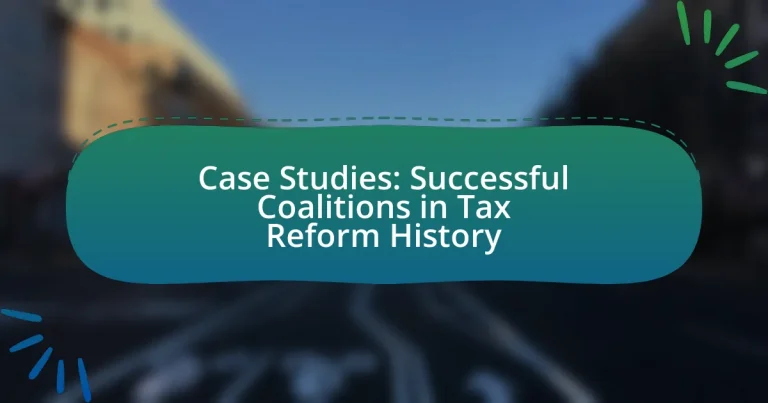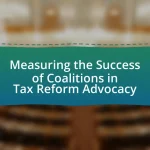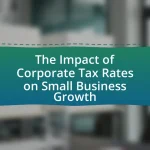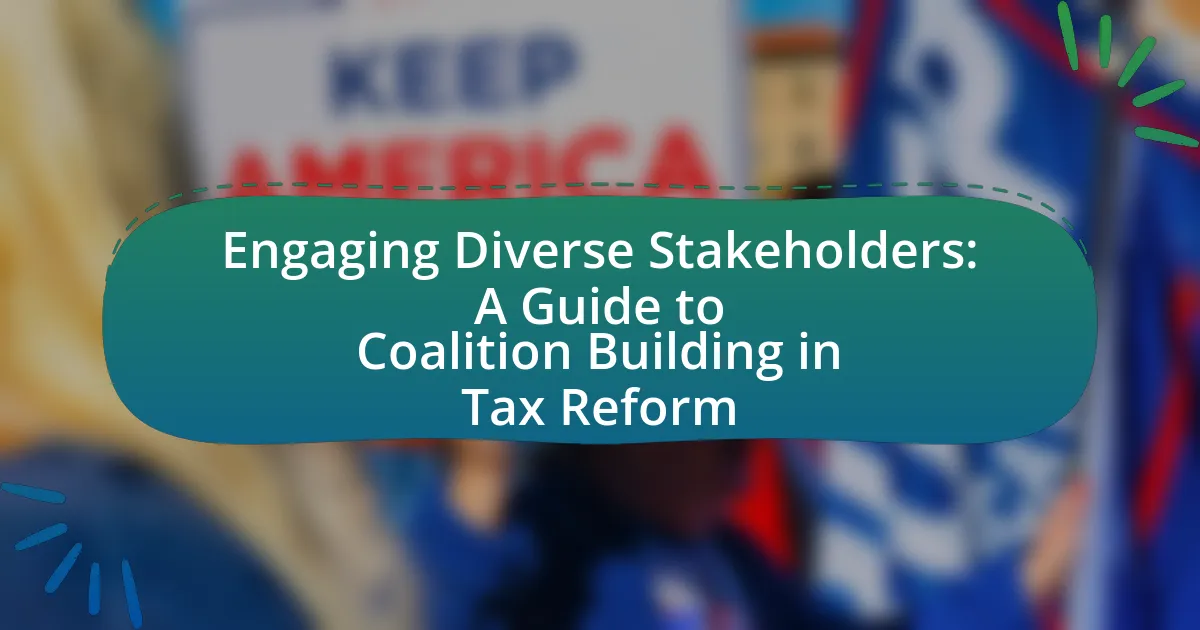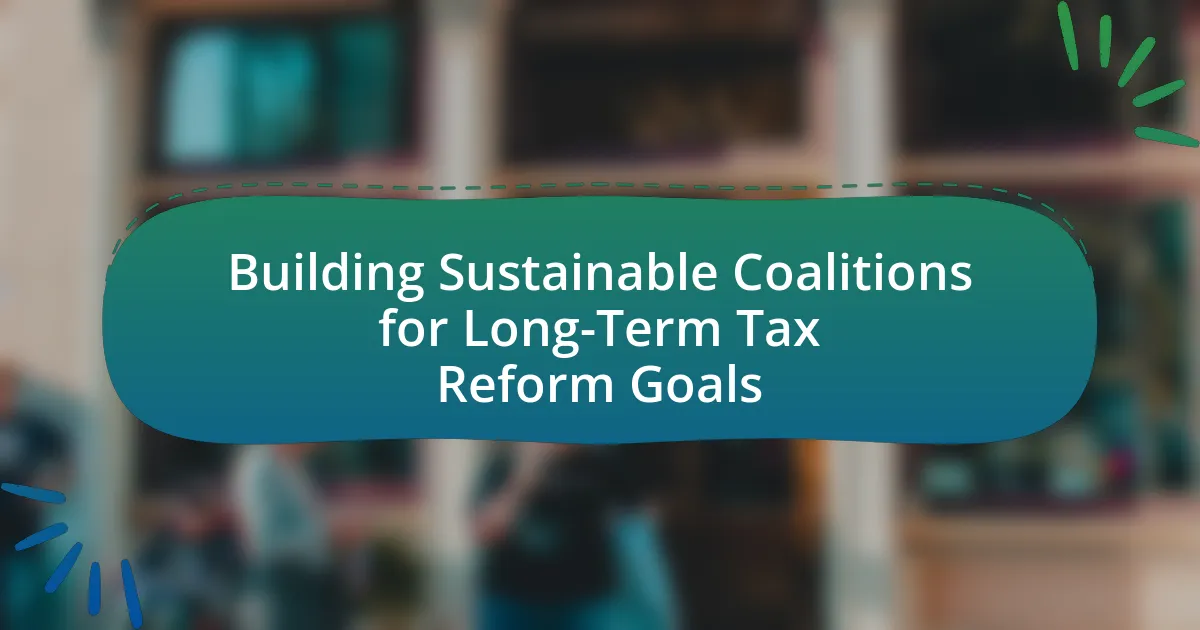The article examines successful coalitions in tax reform history, with a focus on the bipartisan efforts that led to the Tax Reform Act of 1986 in the United States. It highlights how coalitions, comprising diverse stakeholders such as political leaders, business groups, and advocacy organizations, have influenced tax reform outcomes by uniting around common goals. Key factors contributing to the success of these coalitions include strong leadership, clear objectives, and effective communication. The article also discusses strategies for building consensus, managing conflicts, and mobilizing grassroots support, while providing insights from historical examples to inform future tax reform initiatives.
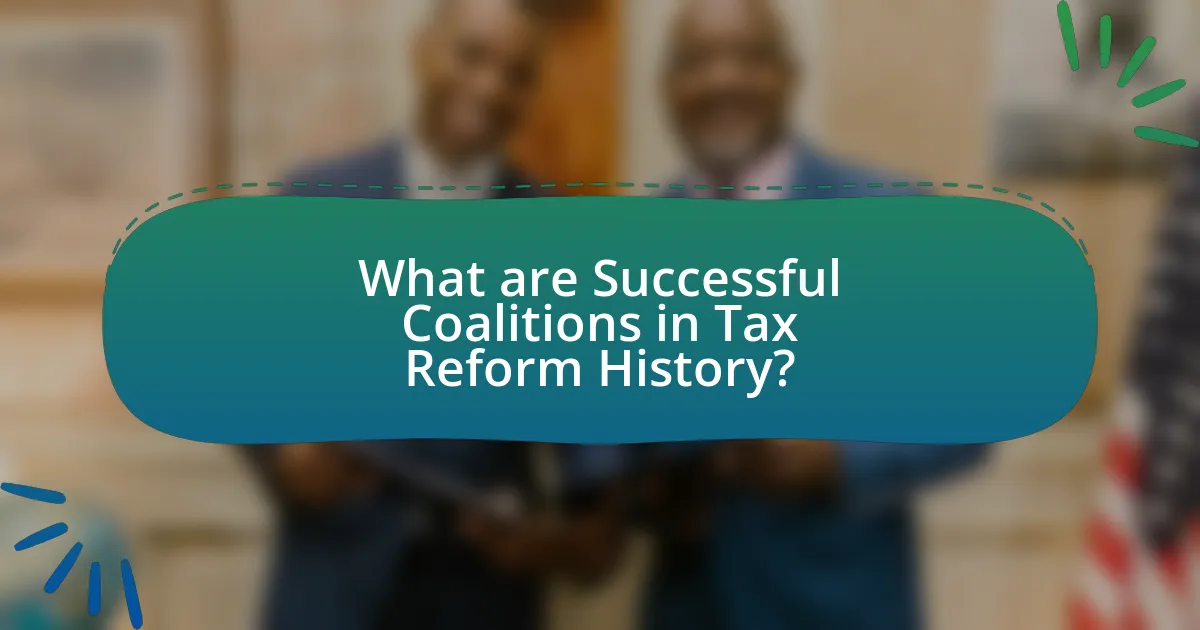
What are Successful Coalitions in Tax Reform History?
Successful coalitions in tax reform history include the bipartisan efforts that led to the Tax Reform Act of 1986 in the United States. This coalition was formed by key political figures from both the Republican and Democratic parties, including President Ronald Reagan and Democratic Senator Bill Bradley, who worked together to simplify the tax code and lower tax rates. The act resulted in a significant reduction in the number of tax brackets and eliminated many tax shelters, which increased compliance and revenue. The success of this coalition is evidenced by the act’s lasting impact on the U.S. tax system, which remains influential in discussions of tax policy today.
How have coalitions influenced tax reform outcomes?
Coalitions have significantly influenced tax reform outcomes by uniting diverse stakeholders to advocate for specific changes. For instance, the coalition of business groups and labor unions in the 1986 Tax Reform Act in the United States successfully lobbied for lower tax rates and the elimination of numerous tax shelters, resulting in a more equitable tax system. This collaboration demonstrated that when various interest groups align their goals, they can effectively shape legislation and overcome political resistance, leading to substantial reforms that reflect a broader consensus.
What key factors contribute to the success of these coalitions?
Key factors that contribute to the success of coalitions in tax reform include strong leadership, clear objectives, and effective communication. Strong leadership ensures that the coalition remains focused and motivated, while clear objectives provide a unified direction for all members. Effective communication fosters collaboration and helps to align the interests of diverse stakeholders. Historical examples, such as the coalition that successfully passed the Tax Reform Act of 1986, demonstrate that these elements are crucial; the coalition was led by influential figures, had specific goals like simplifying the tax code, and maintained open lines of communication among various interest groups, which ultimately facilitated consensus and successful implementation.
How do different stakeholders participate in these coalitions?
Different stakeholders participate in coalitions through collaboration, resource sharing, and advocacy efforts. For instance, government entities provide regulatory frameworks and policy support, while businesses contribute financial resources and expertise. Non-profit organizations often mobilize grassroots support and raise public awareness, and academic institutions may offer research and data analysis to inform coalition strategies. This multi-faceted participation enhances the coalition’s effectiveness in achieving tax reform goals, as evidenced by successful initiatives like the 1986 Tax Reform Act, where diverse stakeholders worked together to create comprehensive tax policy changes.
What historical examples illustrate successful coalitions?
Successful coalitions in history include the Grand Alliance during World War II, which united the United States, the Soviet Union, and the United Kingdom against the Axis powers. This coalition effectively coordinated military strategies and resources, leading to the defeat of Nazi Germany in 1945. Another example is the coalition formed during the American Civil Rights Movement, where diverse groups, including African American leaders, labor unions, and religious organizations, collaborated to achieve landmark legislation such as the Civil Rights Act of 1964. This coalition’s collective efforts resulted in significant social and legal changes in the United States.
What lessons can be learned from the coalition behind the Tax Reform Act of 1986?
The coalition behind the Tax Reform Act of 1986 demonstrates the importance of bipartisan support in achieving significant legislative change. This coalition included key figures from both political parties, such as President Ronald Reagan and Democratic leaders, which facilitated negotiations and compromise. The Act’s success was largely due to the ability of diverse stakeholders, including business groups and advocacy organizations, to unite around common goals, emphasizing the need for collaboration across ideological lines. Historical context shows that the Act lowered tax rates while broadening the tax base, illustrating that effective coalitions can lead to comprehensive reforms that benefit a wide range of constituents.
How did the coalition for the 2017 Tax Cuts and Jobs Act form and succeed?
The coalition for the 2017 Tax Cuts and Jobs Act formed through a strategic alignment of Republican lawmakers, business groups, and conservative advocacy organizations, successfully uniting around the goal of comprehensive tax reform. This coalition succeeded by leveraging a shared vision of stimulating economic growth through tax cuts, which was supported by data indicating that lower corporate tax rates could enhance competitiveness and job creation. Key players, including the Trump administration and influential groups like the National Federation of Independent Business, actively campaigned for the legislation, emphasizing its potential benefits to the economy, which helped to galvanize support among both lawmakers and the public.

What Strategies Do Successful Coalitions Employ?
Successful coalitions employ strategies such as building broad-based support, leveraging data-driven advocacy, and fostering strong communication among stakeholders. These strategies enable coalitions to unite diverse interests and effectively influence policy outcomes. For instance, the coalition behind the Tax Reform Act of 1986 utilized extensive research to demonstrate the economic benefits of tax simplification, which garnered bipartisan support and facilitated the passage of the legislation. Additionally, successful coalitions often engage in grassroots mobilization, as seen in the efforts of the coalition for the Affordable Care Act, which effectively organized public support to influence lawmakers.
How do coalitions build consensus among diverse groups?
Coalitions build consensus among diverse groups by facilitating open communication and fostering mutual understanding. They achieve this through structured dialogue, where representatives from various backgrounds share their perspectives and concerns, allowing for the identification of common goals. For instance, in tax reform efforts, coalitions often employ negotiation techniques that prioritize collaboration over competition, leading to compromises that reflect the interests of all parties involved. Research indicates that successful coalitions, such as the bipartisan efforts in the 1986 Tax Reform Act, utilized inclusive processes that engaged stakeholders from different sectors, resulting in a more comprehensive and widely accepted policy outcome.
What negotiation tactics are commonly used in tax reform coalitions?
Tax reform coalitions commonly use tactics such as consensus building, interest alignment, and strategic framing. Consensus building involves engaging diverse stakeholders to find common ground, which is essential for creating a unified front. Interest alignment focuses on identifying and addressing the specific needs and concerns of different coalition members, ensuring that all parties feel represented and valued. Strategic framing is used to present tax reform proposals in a way that resonates with the public and policymakers, emphasizing benefits and minimizing opposition. These tactics have been effective in historical coalitions, such as the bipartisan efforts during the Tax Reform Act of 1986, which successfully navigated complex negotiations by employing these strategies.
How do coalitions manage conflicts and differing priorities?
Coalitions manage conflicts and differing priorities through structured negotiation, consensus-building, and clear communication. These strategies enable coalition members to articulate their individual goals while finding common ground. For instance, in the context of tax reform, coalitions often establish working groups that focus on specific issues, allowing diverse stakeholders to collaborate on solutions that address multiple interests. Research shows that successful coalitions, such as those formed during the 1986 Tax Reform Act, utilized regular meetings and facilitated discussions to align their objectives, demonstrating that effective conflict management hinges on ongoing dialogue and compromise.
What role does public opinion play in coalition strategies?
Public opinion significantly influences coalition strategies by shaping the priorities and actions of coalition members. When coalitions form around tax reform, they often gauge public sentiment to align their proposals with the electorate’s preferences, ensuring broader support. For instance, in the 1986 Tax Reform Act in the United States, public opinion favored simplification and fairness in the tax code, prompting coalition leaders to adopt these themes in their strategy, which ultimately contributed to the legislation’s success. This alignment with public sentiment not only enhances the legitimacy of the coalition but also increases the likelihood of achieving policy goals, as seen in various historical tax reform efforts.
How do coalitions leverage media to shape public perception?
Coalitions leverage media to shape public perception by strategically disseminating information and narratives that align with their objectives. They utilize press releases, social media campaigns, and targeted advertisements to highlight their messages, often framing issues in a way that resonates with the public. For instance, during the 2017 tax reform debates in the United States, coalitions such as Americans for Tax Reform employed media outlets to promote the benefits of tax cuts, emphasizing economic growth and job creation. This approach was supported by data from the Tax Foundation, which projected that tax reform could lead to increased GDP and wages, thereby influencing public opinion in favor of the coalition’s stance.
What strategies do coalitions use to mobilize grassroots support?
Coalitions mobilize grassroots support through strategies such as community engagement, coalition building, and targeted communication. Community engagement involves organizing local events and forums to educate citizens about tax reform issues, fostering a sense of ownership and involvement. Coalition building focuses on uniting diverse groups with shared interests, enhancing collective strength and resources. Targeted communication utilizes social media and traditional media to disseminate information effectively, reaching specific demographics and encouraging participation. For example, the coalition advocating for the 2017 tax reform in the United States effectively used these strategies to rally support, resulting in significant public engagement and legislative success.
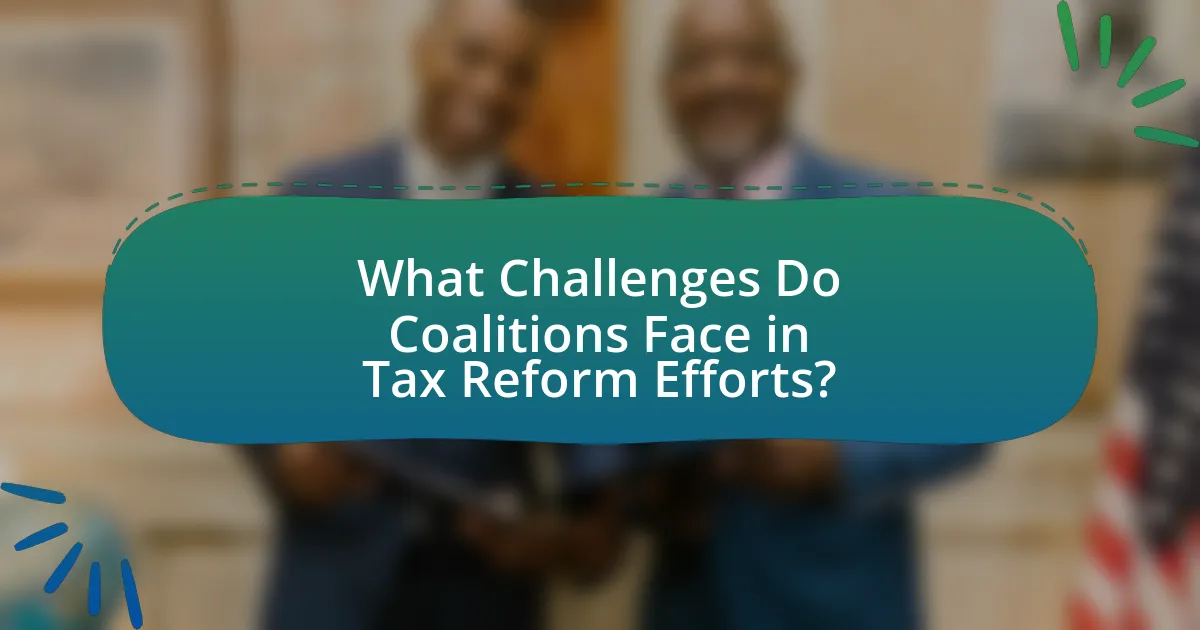
What Challenges Do Coalitions Face in Tax Reform Efforts?
Coalitions face significant challenges in tax reform efforts, primarily due to conflicting interests among diverse stakeholders. These stakeholders often include various political parties, interest groups, and economic sectors, each with distinct priorities and agendas. For instance, a coalition may struggle to reconcile the demands of business groups advocating for lower corporate taxes with the needs of social welfare advocates seeking increased funding for public services. Additionally, coalitions often encounter difficulties in achieving consensus on the specifics of tax policy, which can lead to fragmentation and weakened bargaining power. Historical examples, such as the failed tax reform attempts in the United States during the 1990s, illustrate how internal divisions within coalitions can derail comprehensive reform efforts.
What are the common obstacles encountered by coalitions?
Common obstacles encountered by coalitions include lack of trust among members, conflicting interests, and inadequate communication. These challenges can hinder collaboration and decision-making processes. For instance, research indicates that coalitions often struggle with aligning diverse goals, which can lead to fragmentation and reduced effectiveness. Additionally, poor communication can result in misunderstandings and a lack of cohesion, ultimately undermining the coalition’s objectives.
How do political divisions impact coalition effectiveness?
Political divisions significantly hinder coalition effectiveness by creating barriers to consensus and collaboration among diverse groups. When political factions prioritize their ideological differences over common goals, it leads to fragmentation and inefficiency in decision-making processes. For instance, during the 1986 Tax Reform Act in the United States, bipartisan support was crucial; however, deep political divisions initially stalled negotiations. Research indicates that coalitions with a unified agenda and minimal internal conflict are more likely to achieve legislative success, as evidenced by the eventual passage of the reform, which required extensive compromise among divided interests.
What external factors can hinder coalition progress?
External factors that can hinder coalition progress include political opposition, economic instability, and social unrest. Political opposition can manifest through resistance from rival parties or interest groups, which can obstruct legislative efforts and weaken coalition unity. Economic instability, such as recessions or budget deficits, can divert attention and resources away from coalition goals, making it difficult to maintain momentum. Social unrest, driven by public dissatisfaction or protests, can create an environment of uncertainty that complicates coalition negotiations and implementation of reforms. These factors collectively create challenges that can significantly impede the effectiveness and progress of coalitions in tax reform initiatives.
How can coalitions overcome these challenges?
Coalitions can overcome challenges by fostering strong communication and collaboration among members. Effective communication ensures that all stakeholders are aligned on goals and strategies, which is crucial for maintaining unity and focus. Additionally, coalitions can establish clear roles and responsibilities to leverage the strengths of each member, thereby enhancing overall effectiveness. Historical examples, such as the coalition that successfully advocated for the Tax Reform Act of 1986, demonstrate that diverse groups can achieve significant policy changes by working together, sharing resources, and maintaining a unified front despite differing interests. This coalition’s success was largely attributed to its ability to negotiate compromises and build consensus, illustrating that strategic collaboration is essential for overcoming challenges in tax reform initiatives.
What best practices can coalitions adopt to enhance resilience?
Coalitions can enhance resilience by fostering strong communication and collaboration among members. Effective communication ensures that all stakeholders are informed and engaged, which builds trust and facilitates coordinated responses to challenges. Additionally, coalitions should establish clear goals and shared values to align efforts and maintain focus during crises. Research indicates that coalitions with defined objectives are more likely to adapt and respond effectively to changing circumstances. Furthermore, investing in capacity building, such as training and resource sharing, equips coalition members with the skills needed to navigate uncertainties. A study by the National Council of Nonprofits highlights that resilient coalitions often engage in regular assessments to identify strengths and weaknesses, allowing for proactive adjustments.
How can coalitions adapt to changing political landscapes?
Coalitions can adapt to changing political landscapes by employing strategic communication, flexible policy positions, and building broad-based support. For instance, during the 2017 tax reform efforts in the United States, coalitions of business groups and advocacy organizations adjusted their messaging to emphasize economic growth and job creation, which resonated with a wider audience. This adaptability allowed them to navigate shifting public opinions and political priorities effectively. Additionally, coalitions that remain open to negotiation and compromise can better respond to emerging challenges, as seen in various successful tax reform initiatives where stakeholders modified their proposals to align with the interests of key political players.
What Practical Insights Can Be Gained from Successful Coalitions?
Successful coalitions in tax reform history demonstrate the importance of shared goals, effective communication, and strategic alliances. These coalitions often achieve significant policy changes by uniting diverse stakeholders, which enhances their bargaining power and credibility. For instance, the coalition that successfully advocated for the Tax Reform Act of 1986 included business leaders, policymakers, and advocacy groups, showcasing how collaboration across sectors can lead to comprehensive reforms. This coalition’s success illustrates that aligning interests and fostering trust among participants can create a robust framework for achieving complex legislative objectives.
What are the key takeaways for future tax reform coalitions?
Future tax reform coalitions should prioritize broad stakeholder engagement to ensure diverse perspectives are represented. Successful coalitions in the past, such as the 1986 Tax Reform Act, demonstrated that inclusive dialogue among various interest groups, including businesses, advocacy organizations, and policymakers, leads to more comprehensive and accepted reforms. Additionally, coalitions must focus on clear communication of goals and benefits to the public, as transparency fosters trust and support. Historical evidence shows that reforms with strong public backing, like the 2017 Tax Cuts and Jobs Act, tend to gain traction more easily. Finally, adaptability is crucial; coalitions should be prepared to adjust strategies based on feedback and changing political landscapes, as seen in the evolving approaches during the 1993 and 2001 tax reform efforts.
How can emerging coalitions apply lessons from past successes?
Emerging coalitions can apply lessons from past successes by analyzing effective strategies and tactics used in historical tax reform coalitions. For instance, the coalition that successfully passed the Tax Reform Act of 1986 demonstrated the importance of broad stakeholder engagement and clear communication of benefits to various interest groups. This coalition effectively united diverse parties by emphasizing shared goals, which resulted in a comprehensive reform that garnered bipartisan support. By studying such examples, emerging coalitions can identify key factors like coalition building, strategic messaging, and the importance of timing, which are critical for mobilizing support and achieving legislative goals.
